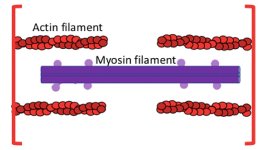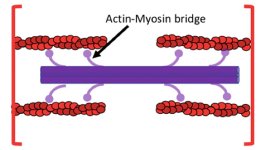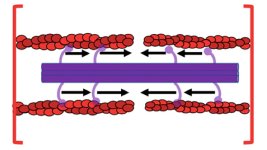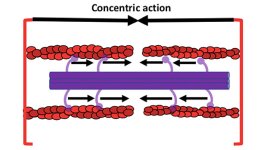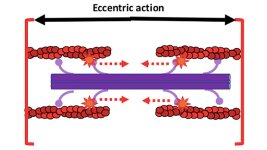Is time under tension really important for hypertrophy?
Does time under tension (TUT) matter for hypertrophy or is that mostly bro-science? Good question.
As a refresher, time under tension refers to the duration in seconds of a set. If you do 10 reps with a 3 second eccentric (lowering phase) and a 1 second concentric (lifting phase) the TUT will be roughly 40 seconds.
Now, does it matter for muscle growth? Yes and no. My recommendation (for most people on most exercises) is just trying to get gradually stronger for sets of 6-10 reps while controlling the eccentric and maintaining tension. This is the best way to stimulate growth.
A Closer Look at TUT
It's not a primary factor involved in growth, and the set duration itself isn't really important. But the physiological response to a certain duration of TUT may play a role in growth.
Did you get that? The TUT itself and the physiological response (lactate and growth factor accumulation during a set lasting 40-60 seconds) are not what I'd call a growth stimulus. But they can increase the adaptation from the stimulus.
So, what's the main stimulus for growth? If we were to use an equation it would look something like this:
Tension is related to the amount of force the muscle needs to produce. The more force required, the higher the tension will be.
Let's look at how muscles contract. Each muscle fiber has actin and myosin filaments. They connect with each other when the myosin heads hook themselves to the actin. This is called a "cross-bridge."
Then, the myosin heads pull the actin, shortening the muscle. (SEE IMAGES BELOW)
Now understand that the more force/tension you need to produce, the more bridges you'll form.
During the eccentric phase of an exercise, when the muscle's fibers are lengthening (being stretched), if the bridges remain connected you create muscle damage and stimulate mTOR activation – the two most important hypertrophy stimuli.
The bridges can only shorten the muscle fiber, they can't lengthen it. If the bridges remain connected, muscle tension is high, and you perform an eccentric action, the load is lengthening the fibers while the bridges are trying to shorten them. This is mechanical stress and it's the main trigger for growth.
That's why if you have zero control of the weight during the eccentric (very low tension), it's much less effective for growth because when you don't actively resist the weight, muscle tension goes down, the number of bridges goes down, and the potential for muscle damage and mTOR activation is lower.
To maximize the mechanical stress you must:
What About TUT?
That's why the number of reps is more important than the time under tension. With every rep you do, you have a new bout of mechanical stress via a new loaded lengthening of the muscle fibers.
Here are two hypothetical scenarios to illustrate my point:
Why? Because the number of times you stretch a muscle fiber in a set has an important impact on muscle damage and mTOR activation. Think of it like this: every time you get to stretch a fiber under load, you trigger growth.
Now if you add a third scenario where you're doing 10 reps with a 5010 tempo (a TUT of 60 seconds) would it be more effective? Nope!
To do that you'd have to use significantly less weight, probably something like 185-195 pounds instead of 225 pounds. The lower weight would lead to less muscle tension and each rep would be less effective.
Caveat: In that example, the longer time under tension will have some benefits that can increase muscle growth though. When you reach the 40-60 second range, if the intensity is high enough so that you reach failure in that time zone, you'll be producing a lot of lactate and growth factors, which can help with the adaptation to training.
The three scenarios in order of effectiveness would be:
The new order would be:
It will never be the main growth stimulus. All it does is lead to certain physiological responses, like lactate and growth factor production, which can play a small role in hypertrophy.
Local growth factors can help stimulate protein synthesis slightly (which speeds up muscle tissue repair and building) while lactate can increase follistatin levels which can inhibit myostatin a bit.
Lower myostatin leads to the possibility of building more muscle. But don't jump on the lactate bandwagon just yet – it likely won't make a huge difference.
I do like to shoot for longer TUT on exercises that won't cause much muscle damage. Think isolation work mainly... especially if the eccentric isn't loaded for the whole range like lateral raises and barbell curls. This would be a good approach with people who have a harder time repairing muscle damage, like older individuals or people with a very high stress level.
For these cases, shooting for a TUT of 40-60 seconds with a moderate weight can be beneficial.
By the way, I use a lot of slow eccentrics. I'm not being contradictory: I use them for other reasons than stimulating maximum growth, like improving motor learning, strengthening tendons and becoming stronger eccentrically.
Does time under tension (TUT) matter for hypertrophy or is that mostly bro-science? Good question.
As a refresher, time under tension refers to the duration in seconds of a set. If you do 10 reps with a 3 second eccentric (lowering phase) and a 1 second concentric (lifting phase) the TUT will be roughly 40 seconds.
Now, does it matter for muscle growth? Yes and no. My recommendation (for most people on most exercises) is just trying to get gradually stronger for sets of 6-10 reps while controlling the eccentric and maintaining tension. This is the best way to stimulate growth.
A Closer Look at TUT
It's not a primary factor involved in growth, and the set duration itself isn't really important. But the physiological response to a certain duration of TUT may play a role in growth.
Did you get that? The TUT itself and the physiological response (lactate and growth factor accumulation during a set lasting 40-60 seconds) are not what I'd call a growth stimulus. But they can increase the adaptation from the stimulus.
So, what's the main stimulus for growth? If we were to use an equation it would look something like this:
- (Muscle fiber recruitment + Mechanical loading of these fibers) X number of reps = hypertrophy stimulus
- Use heavier weights. Heavier weights = greater percentage of your maximum.
- Create fatigue. Do more reps or use supersets, which decreases your relative maximum from rep to rep because the muscle is tired.
- Accelerate as much as possible when lifting the weight (force = mass x acceleration). But you'll see why this is good for strength and power, but not optimal for hypertrophy.
Tension is related to the amount of force the muscle needs to produce. The more force required, the higher the tension will be.
Let's look at how muscles contract. Each muscle fiber has actin and myosin filaments. They connect with each other when the myosin heads hook themselves to the actin. This is called a "cross-bridge."
Then, the myosin heads pull the actin, shortening the muscle. (SEE IMAGES BELOW)
Now understand that the more force/tension you need to produce, the more bridges you'll form.
During the eccentric phase of an exercise, when the muscle's fibers are lengthening (being stretched), if the bridges remain connected you create muscle damage and stimulate mTOR activation – the two most important hypertrophy stimuli.
The bridges can only shorten the muscle fiber, they can't lengthen it. If the bridges remain connected, muscle tension is high, and you perform an eccentric action, the load is lengthening the fibers while the bridges are trying to shorten them. This is mechanical stress and it's the main trigger for growth.
That's why if you have zero control of the weight during the eccentric (very low tension), it's much less effective for growth because when you don't actively resist the weight, muscle tension goes down, the number of bridges goes down, and the potential for muscle damage and mTOR activation is lower.
To maximize the mechanical stress you must:
- Create as many actin-myosin cross-bridges as possible, which is how muscle contracts. The more force you need to produce, the more of those bridges you create.
- Keep tension fairly constant during the rep. That's why too much acceleration can decrease mechanical loading. When you produce too much momentum, you need less force from the muscle to lift the weight, so you decrease the number of bridges formed.
- Lengthen/stretch the fibers while the tension remains high. Less tension means less actin-myosin cross-bridges, which means less hypertrophy stimulation. That's why it's more effective to do the eccentric under control, not fast. The stretching of the fibers while they're producing tension is responsible for muscle damage and mTOR activation.
What About TUT?
That's why the number of reps is more important than the time under tension. With every rep you do, you have a new bout of mechanical stress via a new loaded lengthening of the muscle fibers.
Here are two hypothetical scenarios to illustrate my point:
- A. 10 reps with 225 pounds and a 2010 tempo (2 seconds to lower, no pause at the bottom, 1 second to lift, no pause at the top). That's a TUT of 30 seconds because each rep took 2 seconds to lower.
- B. 5 reps with 225 pounds and a 5010 tempo. That's still a TUT of 30 seconds because each rep took 5 seconds to lower... but you did fewer total reps.
Why? Because the number of times you stretch a muscle fiber in a set has an important impact on muscle damage and mTOR activation. Think of it like this: every time you get to stretch a fiber under load, you trigger growth.
Now if you add a third scenario where you're doing 10 reps with a 5010 tempo (a TUT of 60 seconds) would it be more effective? Nope!
To do that you'd have to use significantly less weight, probably something like 185-195 pounds instead of 225 pounds. The lower weight would lead to less muscle tension and each rep would be less effective.
Caveat: In that example, the longer time under tension will have some benefits that can increase muscle growth though. When you reach the 40-60 second range, if the intensity is high enough so that you reach failure in that time zone, you'll be producing a lot of lactate and growth factors, which can help with the adaptation to training.
The three scenarios in order of effectiveness would be:
- 10 reps at 225 pounds with a 2010 tempo
- 10 reps at 195 pounds with a 5010 tempo
- 5 reps at 225 pounds with a 5010 tempo
The new order would be:
- 10 reps at 225 pounds with a 2010 tempo
- 10 reps at 195 pounds with a 5010 tempo
- 5 reps at 225 pounds with a 2010 tempo
It will never be the main growth stimulus. All it does is lead to certain physiological responses, like lactate and growth factor production, which can play a small role in hypertrophy.
Local growth factors can help stimulate protein synthesis slightly (which speeds up muscle tissue repair and building) while lactate can increase follistatin levels which can inhibit myostatin a bit.
Lower myostatin leads to the possibility of building more muscle. But don't jump on the lactate bandwagon just yet – it likely won't make a huge difference.
I do like to shoot for longer TUT on exercises that won't cause much muscle damage. Think isolation work mainly... especially if the eccentric isn't loaded for the whole range like lateral raises and barbell curls. This would be a good approach with people who have a harder time repairing muscle damage, like older individuals or people with a very high stress level.
For these cases, shooting for a TUT of 40-60 seconds with a moderate weight can be beneficial.
By the way, I use a lot of slow eccentrics. I'm not being contradictory: I use them for other reasons than stimulating maximum growth, like improving motor learning, strengthening tendons and becoming stronger eccentrically.

